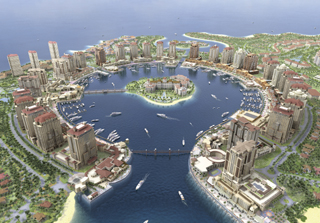
Callison
Specialty: Retail and mixed-use
Management: Bill Karst, CEO; Bob Tindall, chairman; John Bierly, president; Paula Stafford, executive vice president; Steve Epple, executive vice president
Founded: 1975
Headquarters: Seattle
2007 revenues: $157 million
Projected 2008 revenues: $187 million
Current projects: The Bravern; 2201 Westlake; Microsoft West Campus; The Pearl-Qatar near Doha, Qatar; EverVail in Vail, Colo.; Hopson Plaza in Shanghai, China.

Image courtesy of Callison Callison is designing a lot of international projects, including The Pearl-Qatar, which consists of 31 residential towers on an artificial island.
|
Paula Stafford, executive vice president of Callison, said the economic downturn “didn’t really hit the company” until the beginning of October because it had been well insulated by work in many markets around the world.
The Middle East is strong for the company, and it has many projects in China. Stafford is proud that the company is working on projects like The Pearl-Qatar, 31 residential towers on a 14 million-square-foot island community near Doha, Qatar. She said it is a culmination of the firm’s 23 years of experience.
Callison also does a lot of work with domestic and international luxury retail brands like Louis Vuitton and Hugo Boss, which Stafford said are showing no signs of softening at all, though that could change in the future. “The luxury brands are still performing strong and they are still being very bullish about their programs,” she said. “We don’t see any evidence of a downturn and slowdown in those markets.”
Layoffs likely
But that doesn’t go for financial institutions. Both Washington Mutual and Wachovia, two of the banks that have been gobbled up in the recent credit crunch, were clients of Callison. Now, the company is in a wait-and-see mode for both of those contracts. It is moving ahead on projects that are too far along to stop, but future projects are on hold.
Stafford said the company will try to shift the people from both bank teams to other offices or other teams, but there will likely be some layoffs. Callison had been working with WaMu for about 20 years, so Stafford said it is “painful” to see that company end and it “hurts the city in general.”
Seeing those changes locally, she said, has made her happy that Callison works in diversified markets around the world. “I’m glad we’re in a place where we’re not totally dependent on the local economy,” she said. “I think any company that has a regional focus, it’s going to be more challenging because there’s going to be fewer opportunities. Everyone’s looking at pulling back.”
Rethinking retail
But Stafford thinks Callison has a lot to give its retail clients in these trying times. Retail clients, she said, have to rethink how to drive customers to their stores, and how to keep them coming back. Those who keep building stores the same way they always have won’t survive, she said.
Rather than looking at monumental plans where a business rethinks a whole brand, she said companies will be looking at low-cost moves that can have a bigger impact, like visual programs or floor rearrangements. “We may have very different focus areas for our existing clients than we’ve had before,” she said. “Their needs today are very different than a month ago.”
Combine that with a trend she’s seen recently where retail clients move into new markets and countries, and there are a lot of opportunities for exciting design. For example, Cole Haan is looking at moving into the Middle East. United Kingdom brand Harvey Nichols is opening stores in Dubai and Jakarta. Apple is moving into the European market.
“It’s usually not a direct translation,” she said. “There’s a lot of work there.”
For now, Callison is sticking with the markets and clients it knows. “I don’t think it’s a time where we would take on anything new,” she said. “Our strategy is more focused on being strong in the markets we’re already committed to.”